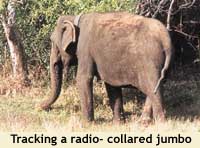 |
 15th November 1998 |
Front Page| |
Man, jumbo: both have to liveAlarmed by escalating deaths elephant experts in the country will pitch in to formulate a single national policy at a full day workshop next Thursday By Hiranthi FernandoHundred -and- thirty seven elephants are reported to have died last year. This is the highest annual record of elephant deaths in the country. It includes deaths by natural causes as well as those killed by man. For the ten months of 1998, 130 deaths of elephants have already been recorded. Experts say, there may have been more deaths of elephants deep in the jungles, which have not been recorded. A shrinking habitat and increasing conflict between man and elephant have led to a decline in the elephant population in recent years. This week, a representative gathering of experts, policy makers, wild life enthusiasts and interested organizations will meet at a full day workshop to discuss ways and means of achieving a national policy on elephant conservation.
Among the main objectives of the five year GEF Project in Sri Lanka is the long term conservation of Sri Lanka's elephant population and the resolution of the severe human elephant conflict. (HEC). With a funding of US $ 4.5 Million from UNDP, the GEF has engaged national and international consultants and advisors to work on the project in association with the Department of Wild Life Conservation (DWLC). The experts are brought in through the Food & Agricultural Organization (FAO). Chief Technical Advisor for the project, H.S. Panwar has worked with the project since its inception in 1994. Panwar, has been involved in wild life conservation on a national scale in his country, for over 20 years. Director of "Project Tiger" which encompassed several areas with elephants, he was also the founder Director of the Wild Life Institute in India for nine years, dealing with research, training and management of all varieties of animals and habitat in the country. "Sri Lanka is rich in natural habitat. The dry zone has rich potential habitats for elephants and other wild life as well," Panwar said. These areas, he points out, are coming in for intensive development. With the growth in human population, much land has been diverted to irrigated farming, chena cultivation, homesteads and home gardening. "Sri Lankans have had a good knowledge of the distribution of elephants, ranging, extent of habitats and so on. They have visualised the main habitat areas and linking corridors," Mr. Panwar observed. He explained that when the Mahaweli Programme first came about, areas were earmarked as new national parks, nature reserves and corridor areas. Protection of these areas during development was assured .Land on both banks of the Mahaweli were marked for conservation, through the Flood plains and forest corridor to Somawathiya and Trinconamadu on the East Coast, while Wasgamuwa, Minneriya, and Giritale had connecting corridors. "Unfortunately, with the accelerated Mahaweli Scheme, all these assurances were bypassed.All the corridors were decimated and the land was taken for agriculture,"he said.
"As a result of the degradation and fragmentation of natural habitats and the decimation of corridors, elephants face a two- way jeopardy," Panwar said. Habitats are limited or degraded, boundaries between natural habitats and cultivated lands have increased and animals are hemmed in. They intrude into human settlement areas, where crops also act as an attraction. This leads to crop damage and conflict with humans. People also lay traps to hunt for animals. Elephants injured by these traps become more aggressive resulting in more damage and are hazard to human life. Thus the human elephant conflict is one of the major issues which needs to be mitigated in planning for the conservation of elephants. The other objective is the long term conservation of a considerable population of elephants in the country. Here, the country should review its policy and and come up with long- term elephant management programme. The lack of a national policy has been a drawback, resulting in ad hoc programmes being carried out. "The biology of the elephant has not changed, only the ground conditions," Panwar commented. "It is a formidable challenge to provide the ecological requirement of elephants while sustaining development." "There are some options today, and these must be implemented today. Tomorrow will be too late," Panwar stressed. He said there are some elephant corridors, which may have some modest settlements in between. It may be possible to revive corridors of 10 to 15 kilometres by relocating a few settlements. The villagers should be given alternative settlements. If they could be happily settled, the crucial corridors could also be revived. Ajay Desai, another FAO consultant from India, is an expert on Elephant Management. He has carried out detailed studies with the assistance of two intensive research programmes by the University of Colombo, funded by GEF. Through these programmes, which covered the North Western and Southern Provinces, a long term study of the elephant ecology and ranging behaviour was carried out. Radio collared elephants and associated herds are being monitored to understand habitat usage, ranging and feeding patterns. A socio-economic study is also being carried out on the effect of elephants on human settlements and the attitude of villagers towards elephants. The studies have revealed valuable information on the ranging patterns of elephants. It has been found that corridors are critical for the long term conservation of elephants. The movement of males results in breeding in different groups. If there are continuing links, inbreeding is less. Corridors are necessary where fragmentation of natural habitats has taken place because elephants have to move through the corridors from one habitat to another. Desai who has studied elephants for 12 to 13 years has completed a technical report for comments and come up with suggestions which would be taken up at a workshop to be held on November 19. It has been suggested that since large areas are required for conservation of elephants, these areas be identified and designated at the earliest, taking the best possible network within what remains today as suitable habitat. In selecting these areas, the main focus should be on the existing Protected Areas (PA) of the DWLC or PA clusters, that is the National Parks, Strict Nature Reserves, Sanctuaries and Nature Reserves all of which covers 12% of the country's land area. To supplement the capacity of the Protected Areas, Forest Reserves under the management of the Forest Department, which amount to about 2% plus some additional government forest could be selected, limiting the selection to those areas that are important for elephant conservation. Panwar stressed that it is important not to set up new settlements in habitat areas and corridor areas since the settlements would have critical problems. Karuwalagaswewa is an example of such an area. Speaking of elephants in some problem areas, he said it is not easy to drive them to other areas when large numbers are involved. However he believes that some elephants in these problem areas could be captured and trained for use in the wild life parks as they do in India. These measures however require policy decisions, he adds. "So many people are genuinely concerned and knowledgeable about the problems of elephant conservation.Our efforts are concentrated on putting all these minds together to develop a workable National Plan.With the report of Ajay Desai supplemented by the research studies, we have a good basis to proceed on," Panwar said. |
||
 |
Front Page| News/Comment| Editorial/Opinion| Business| Sports | Mirror Magazine |
|
 |
Please send your comments and suggestions on this web site to |
|
 Leading
up to this move, the Global Environment Facility (GEF) Project has been
working towards an effective conservation management programme for several
years. GEF is a special global programme dedicated to the care of the world's
environment. The United Nations Development Programme (UNDP), United Nations
Environment Programme (UNEP) and the World Bank support the GEF in its
efforts to conserve the bio-diversity of the world.
Leading
up to this move, the Global Environment Facility (GEF) Project has been
working towards an effective conservation management programme for several
years. GEF is a special global programme dedicated to the care of the world's
environment. The United Nations Development Programme (UNDP), United Nations
Environment Programme (UNEP) and the World Bank support the GEF in its
efforts to conserve the bio-diversity of the world.  Panwar
says there has been a phenomenal growth in the livestock population and
Free grazing by large numbers of cattle in the dry zone forests had also
degraded natural habitats. He says almost 75% of the cattle are owned not
by villagers but by big- time "mudalalis"who are making money
from their cattle breeding, with no feeding costs and ruining the habitats.
Schemes like the Uda Walawe and Kirindi Oya have also affected the conservation
of elephants.
Panwar
says there has been a phenomenal growth in the livestock population and
Free grazing by large numbers of cattle in the dry zone forests had also
degraded natural habitats. He says almost 75% of the cattle are owned not
by villagers but by big- time "mudalalis"who are making money
from their cattle breeding, with no feeding costs and ruining the habitats.
Schemes like the Uda Walawe and Kirindi Oya have also affected the conservation
of elephants.